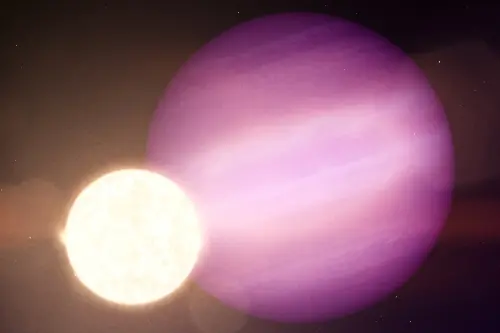
Astronomers have discovered a freezing-cold world orbiting within the so-called "forbidden zone" around a dying star in which planets are normally destroyed.
The 5.8-billion-year-old white dwarf—catchily dubbed "WD 1856+534"—lies just 82 light-years from Earth in the constellation of Draco.
Back in 2020, NASA's Transiting Exoplanet Survey Satellite (TESS) and several ground-based observatories detected a Jupiter-sized object transiting (passing in front of) the white dwarf every 1.4 days.
It was not clear then whether this object, "WD 1856+534b," was a massive planet or a low-mass brown dwarf star—particularly because it was in such a tight orbit, nearly 30 times closer to its star than Mercury is to our own sun.
In a new study, however, researchers led by Mary Anne Limbach of the University of Michigan used the James Webb Space Telescope to confirm that WD 1856+534b is indeed a planet—albeit one in a very unexpected place.
At the end of their lives, as they begin to run out of nuclear fuel, low-to-intermediate mass stars like the sun first balloon into red giants, before shedding their outer layers to leave behind a dense remnant core—a white dwarf.
A planet orbiting far enough out from its host star can survive the latter's transformation into a red giant. In fact, astronomers have discovered a number of exoplanets like this.
But those within an orbital radius of two astronomical units—the "forbidden zone"—are expected to be scoured away by the red giant's expansion.
However, recent observations have begun to hint that some planets may nevertheless be found within the forbidden zone—with WD 1856+534b being the first confirmed example.
In their study, Limbach and colleagues were able to pin down WD 1856+534b by subtracting a detailed model of the light coming from the star from that observed using the Webb telescope's Mid-Infrared Instrument—leaving behind the faint glow from the orbiting object.
Analysis of this signal not only confirmed that WD 1856+534b is indeed a planet, but also revealed that it likely has a mass of around 5.2 times that of Jupiter and a surface temperature of -125 degrees Fahrenheit.
This makes the world the coldest exoplanet whose light has ever been observed directly (although this is far from the chilliest world we know of; OGLE-2005-BLG-390Lb, near the Milky Way's core, has a surface temperature around -370 degrees Fahrenheit.)
As for how WD 1856+534b managed to survive being in the forbidden zone when its star went red giant—well, the answer is that it didn't.
Instead, the researchers believe that it started out in a more-distant orbit before migrating into the forbidden zone after the star has settled down into a white dwarf, perhaps as the result of the gravitational influence of another planet or star.
Do you have a tip on a science story that Newsweek should be covering? Do you have a question about white dwarfs? Let us know via [email protected].
Reference
Limbach, M. A., Vanderburg, A., MacDonald, R. J., Stevenson, K. B., Jenkins, S., Blouin, S., Rauscher, E., Bowens-Rubin, R., Gallo, E., Mang, J., Morley, C. V., Sing, D. K., O'Connor, C., Venner, A., & Xu, S. (2025). Thermal Emission and Confirmation of the Frigid White Dwarf Exoplanet WD 1856+534 b. The Astrophysical Journal Letters, 984(1). https://doi.org/10.3847/2041-8213/adc9ad
